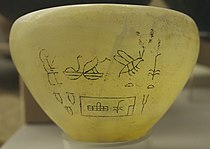Nebty name
| Nebty name in hieroglyphs | |||
|---|---|---|---|
Full title
nebty He of Nekhbet and Wadjet (He of the Two Ladies) |
|||
| Nebty name of king Semerkhet | |||
The Nebty name (also called Two-Ladies-name) was one of the "great five names" used by Egyptian pharaohs. It was also one of the eldest royal titles. The modern term "Two-Ladies-name" is a simple derivation from the translation of the Egyptian word nebty.
The terms "Nebty name" and "Two-Ladies-name" derive from the Egyptian word nbtj (Nebty), which is a dual noun meaning "the (two) ladies". As a mere noun it is a religious euphemism paraphrasing the goddesses Nekhbet and Wadjet as a deified pair. As a royal crest it was thought to represent a unified Egypt.
The Nebty name, similarly to the later Niswt-Bity name, was constructed with two sign groups. The first one shows a griffon vulture sitting on a basket. The second group shows an erect cobra, also sitting on a basket. The eldest versions of the Nebty name showed instead of the cobra the red crown above the second basket. Interestingly, the sign groups forming the Nebty name were never used separately.
The Nebty name was symbolically linked to the two most important goddesses of Ancient Egyptian kingship: Nekhbet and Wadjet. Whilst Nekhbet (Egypt. Nekhebety; "she from Nekheb") was the "mistress of Upper Egypt", her pendant Wadjet (Egypt. Wadyt; "she who thrives" or simply "lady of the green") was the "mistress of Lower Egypt". Nekhbet was worshipped as the "celestial mother of a king", which is expressed in the Ancient Egyptian queen title Mwt-niswt ("mother of the king"). The cobra of Wadjet was worshipped as the "celestial diadem snake on the king's forehead", believed to spit fire at anyone who dared to take on the pharaoh. This protective behaviour made Wadjet become very popular and already in early dynastic times several deities were depicted as wearing a uraeus on their foreheads. With the Nebty name each pharaoh wished to present himself as the one under the guidance and protection of the two goddesses, thus legitimizing himself as being ruler of the whole of Egypt.
After the Horus name, the Nebty name is the second eldest royal name of Ancient Egyptian history and also known as "Two-Ladies name". Egyptologists such as Toby Wilkinson and Ludwig David Morenz point to an obvious prototype of the Nebty name used before the introduction of the final form: ivory tags from the abydene tombs of the kings Hor-Aha, Djer and queen Neithhotep show the Two-Ladies crest with the red crown instead of the cobra over a basket. In the case of Hor-Aha the Nebty crest is of special interest, because it is depicted inside a three-framed building (shrine? tomb?) together with the hieroglyph Men (gardiner sign Y5; meaning "to stay" or "to endure"). It is intensely disputed, if this sign group merely gives the name of a Nebty shrine (Men-Nebty; "where the Two Ladies endure"), if it shows Aha's Nebty name inside his tomb or if it shows instead Narmer's Nebty name, indicating that Aha buried Narmer. The ivory tags of kings Djer and Djet show the prototype inside a palace and a shrine, guided by the notation that the kings visited the palace of the Two Ladies or oversaw the building of wine cellars for the Nebty shrine. The first and infinite use of the final form of the Nebty crest (vulture and cobra over two baskets) appear during the reign of king Semerkhet, who called himself Iry-Nebty ("guardian of the Two Ladies"). After him, every future king used a Nebty name, though not every king of Early Dynasty and Old Kingdom is known by his Nebty name.
...
Wikipedia

